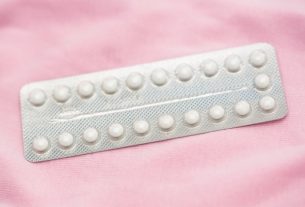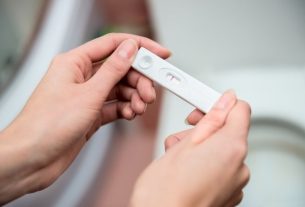The table is a contraceptive method based on analyzing the length of the menstrual cycle to identify a woman’s most fertile days. On these days, the woman should avoid having sexual intercourse or use other contraceptive methods if she does not want to become pregnant.
However, the table is not a completely effective method to avoid pregnancy, because some women may have an irregular menstrual cycle or have their fertile period influenced by emotional situations, for example.
If you have any doubts about the table method, it is important to consult your gynecologist, who can advise on the best contraceptive methods to avoid pregnancy and sexually transmitted infections. Discover the main contraceptive methods.

How it works
The table method is based on analyzing the length of a woman’s menstrual cycle to identify the most fertile period of the cycle. It is during this period that, if there is unprotected sexual intercourse, there is a greater chance of pregnancy.
Online table
To calculate the table and find out the days on which you should avoid having unprotected sex, fill in the calculator with the characteristics of your menstrual cycle:
When knowing when the chance of getting pregnant is greatest, women should avoid having unprotected sex during this period in order to avoid an unwanted pregnancy.
How to make the table manually
To use the table to avoid getting pregnant, you must:
- Count the length of the menstrual cyclealways considering the 1st day as the day on which menstruation begins, because the table is not recommended for women with cycles lasting less than 26 or more than 32 days and very irregular cycles;
- Start counting on the first day of menstruationwhich is considered the 1st day of the cycle;
- From the 1st to the 7th day is not considered a fertile period and the chance of getting pregnant when having unprotected sex tends to be lower. However, it is possible that menstrual bleeding is still happening during this period;
- From the 8th to the 19th day, the woman is considered to be in her fertile period.and it is recommended to avoid having sexual intercourse or use other contraceptive methods on these days, such as condoms or diaphragms.
- From the 20th day until the end of the cycle, it is no longer considered a fertile period.making it possible to have unprotected sex again, because the risk of getting pregnant is lower.
- Restart the count on the first day of menstruationwhich is when a new cycle begins.
Furthermore, as the pill is not as effective a method to prevent pregnancy as condoms or the pill, for example, it is also recommended to use other contraceptive methods.
Can I use the table to get pregnant?
Although the table was created to prevent pregnancy, the method can also be used by women who wish to become pregnant, as it helps to identify the most fertile period of the menstrual cycle, which is when there is a greater chance of ovulation occurring. Find out how to use the table to get pregnant.
Does the table method really work?
The chart is not a completely effective method for preventing pregnancy, especially in women with menstrual cycles outside the 26 to 32 day range. About 5 women out of every 100 get pregnant in the first year, even when the table is used correctly.
Bibliography
- THE AMERICAN COLLEGE OF OBSTETRICIANS AND GYNECOLOGISTS. Fertility Awareness-Based Methods of Family Planning. . Accessed on February 8, 2023
- STATPEARLS. Contraception. 2022. Available at: <https://www.ncbi.nlm.nih.gov/books/NBK536949/>. Accessed on February 8, 2023
- DUANE, Marguerite et al. Fertility Awareness-Based Methods for Women’s Health and Family Planning. Front Med (Lausanne). Vol. 9. 858977, 2022
- TATPEARLS. Natural Family Planning. 2022. Available at: <https://www.ncbi.nlm.nih.gov/books/NBK546661/>. Accessed on February 8, 2023
- CDC. Standard Days Method. Available at: <https://www.cdc.gov/reproductivehealth/contraception/mmwr/spr/days.html>. Accessed on February 8, 2023
- SIMMONS, Rebecca G; JENNINGS, Victoria. Fertility awareness-based methods of family planning. Best Pract Res Clin Obstet Gynaecol. Vol.66. 68-82, 2020
- Regarding: “Table calculator”:
- CDC. Standard Days Method. Available at: <https://www.cdc.gov/reproductivehealth/contraception/mmwr/spr/days.html>. Accessed on March 1, 2023
- DUANE, Marguerite et al. Fertility Awareness-Based Methods for Women’s Health and Family Planning. Front Med (Lausanne). Vol. 9. 858977, 2022
- STATPEARLS. Natural Family Planning. 2022. Available at: <https://www.ncbi.nlm.nih.gov/books/NBK546661/>. Accessed on February 15, 2023
- SIMMONS, Rebecca G; JENNINGS, Victoria. Fertility awareness-based methods of family planning. Best Pract Res Clin Obstet Gynaecol. Vol.66. 68-82, 2020
- THE AMERICAN COLLEGE OF OBSTETRICIANS AND GYNECOLOGISTS. Fertility Awareness-Based Methods of Family Planning. . Accessed on March 1, 2023
- STATPEARLS. Contraception. 2022. Available at: <https://www.ncbi.nlm.nih.gov/books/NBK536949/>. Accessed on March 1, 2023

Sign up for our newsletter and stay up to date with exclusive news
that can transform your routine!
Warning: Undefined array key "title" in /home/storelat/public_html/wp-content/plugins/link-whisper-premium/templates/frontend/related-posts.php on line 12
Warning: Undefined array key "title_tag" in /home/storelat/public_html/wp-content/plugins/link-whisper-premium/templates/frontend/related-posts.php on line 13



